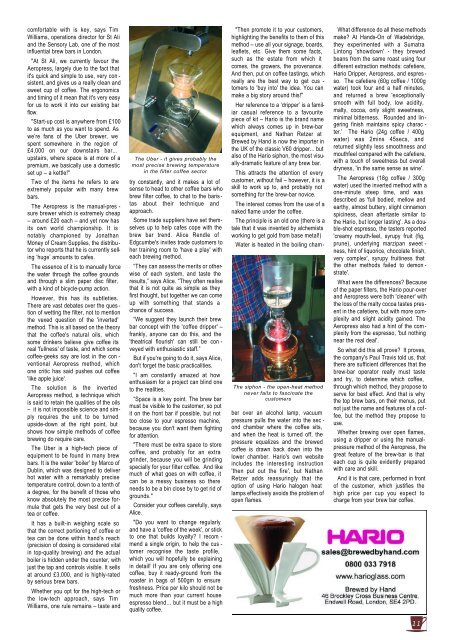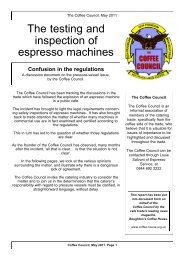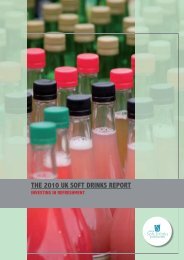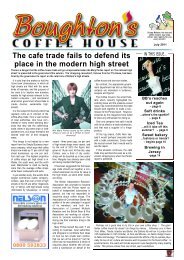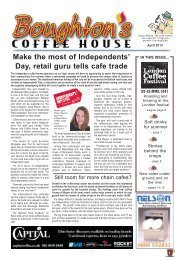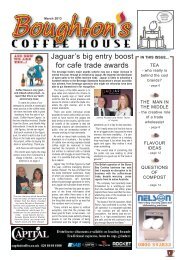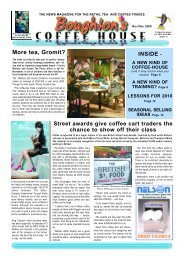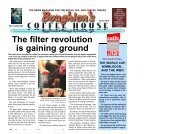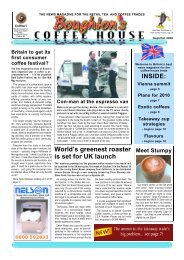British Arm Of Coffee Kids Goes Out On - Boughton's Coffee House
British Arm Of Coffee Kids Goes Out On - Boughton's Coffee House
British Arm Of Coffee Kids Goes Out On - Boughton's Coffee House
You also want an ePaper? Increase the reach of your titles
YUMPU automatically turns print PDFs into web optimized ePapers that Google loves.
comfortable with is key, says Tim<br />
Williams, operations director for St Ali<br />
and the Sensory Lab, one of the most<br />
influential brew bars in London.<br />
"At St Ali, we currently favour the<br />
Aeropress, largely due to the fact that<br />
it's quick and simple to use, very con -<br />
sistent, and gives us a really clean and<br />
sweet cup of coffee. The ergonomics<br />
and timing of it mean that it's very easy<br />
for us to work it into our existing bar<br />
flow.<br />
"Start-up cost is anywhere from £100<br />
to as much as you want to spend. As<br />
we’re fans of the Uber brewer, we<br />
spent somewhere in the region of<br />
£4,000 on our downstairs bar...<br />
upstairs, where space is at more of a<br />
premium, we basically use a domestic<br />
set up – a kettle!"<br />
Two of the items he refers to are<br />
extremely popular with many brew<br />
bars.<br />
The Aeropress is the manual-pres -<br />
sure brewer which is extremely cheap<br />
– around £20 each – and yet now has<br />
its own world championship. It is<br />
notably championed by Jonathan<br />
Money of Cream Supplies, the distributor<br />
who reports that he is currently selling<br />
‘huge’ amounts to cafes.<br />
The essence of it is to manually force<br />
the water through the coffee grounds<br />
and through a slim paper disc filter,<br />
with a kind of bicycle-pump action.<br />
However, this has its subtleties.<br />
There are vast debates over the ques -<br />
tion of wetting the filter, not to mention<br />
the vexed question of the 'inverted'<br />
method. This is all based on the theory<br />
that the coffee's natural oils, which<br />
some drinkers believe give coffee its<br />
real 'fullness' of taste, and which some<br />
coffee-geeks say are lost in the con -<br />
ventional Aeropress method, which<br />
one critic has said pushes out coffee<br />
'like apple juice'.<br />
The solution is the inverted<br />
Aeropress method, a technique which<br />
is said to retain the qualities of the oils<br />
– it is not impossible science and simply<br />
requires the unit to be turned<br />
upside-down at the right point, but<br />
shows how simple methods of coffee<br />
brewing do require care.<br />
The Uber is a high-tech piece of<br />
equipment to be found in many brew<br />
bars. It is the water 'boiler' by Marco of<br />
Dublin, which was designed to deliver<br />
hot water with a remarkably precise<br />
temperature control, down to a tenth of<br />
a degree, for the benefit of those who<br />
know absolutely the most precise formula<br />
that gets the very best out of a<br />
tea or coffee.<br />
It has a built-in weighing scale so<br />
that the correct portioning of coffee or<br />
tea can be done within hand’s reach<br />
(precision of dosing is considered vital<br />
in top-quality brewing) and the actual<br />
boiler is hidden under the counter, with<br />
just the tap and controls visible. It sells<br />
at around £3,000, and is highly-rated<br />
by serious brew bars.<br />
Whether you opt for the high-tech or<br />
the low-tech approach, says Tim<br />
Williams, one rule remains – taste and<br />
The Uber - it gives probably the<br />
most precise brewing temperature<br />
in the filter coffee sector<br />
try constantly, and it makes a lot of<br />
sense to head to other coffee bars who<br />
brew filter coffee, to chat to the baris -<br />
tas about their technique and<br />
approach.<br />
Some trade suppliers have set themselves<br />
up to help cafes cope with the<br />
brew bar trend. Alice Rendle of<br />
Edgcumbe's invites trade customers to<br />
her training room to 'have a play' with<br />
each brewing method.<br />
“They can assess the merits or otherwise<br />
of each system, and taste the<br />
results,” says Alice. “They often realise<br />
that it is not quite as simple as they<br />
first thought, but together we can come<br />
up with something that stands a<br />
chance of success.<br />
“We suggest they launch their brew<br />
bar concept with the 'coffee dripper' –<br />
frankly, anyone can do this, and the<br />
'theatrical flourish' can still be con -<br />
veyed with enthusiastic staff.”<br />
But if you're going to do it, says Alice,<br />
don't forget the basic practicalities.<br />
"I am constantly amazed at how<br />
enthusiasm for a project can blind one<br />
to the realities.<br />
“Space is a key point. The brew bar<br />
must be visible to the customer, so put<br />
it on the front bar if possible, but not<br />
too close to your espresso machine,<br />
because you don't want them fighting<br />
for attention.<br />
"There must be extra space to store<br />
coffee, and probably for an extra<br />
grinder, because you will be grinding<br />
specially for your filter coffee. And like<br />
much of what goes on with coffee, it<br />
can be a messy business so there<br />
needs to be a bin close by to get rid of<br />
grounds."<br />
Consider your coffees carefully, says<br />
Alice.<br />
"Do you want to change regularly<br />
and have a 'coffee of the week', or stick<br />
to one that builds loyalty? I recom -<br />
mend a single origin, to help the cus -<br />
tomer recognise the taste profile,<br />
which you will hopefully be explaining<br />
in detail! If you are only offering one<br />
coffee, buy it ready-ground from the<br />
roaster in bags of 500gm to ensure<br />
freshness. Price per kilo should not be<br />
much more than your current house<br />
espresso blend… but it must be a high<br />
quality coffee.<br />
"Then promote it to your customers,<br />
highlighting the benefits to them of this<br />
method – use all your signage, boards,<br />
leaflets, etc. Give them some facts,<br />
such as the estate from which it<br />
comes, the growers, the provenance.<br />
And then, put on coffee tastings, which<br />
really are the best way to get cus -<br />
tomers to 'buy into' the idea. You can<br />
make a big story around this!"<br />
Her reference to a ‘dripper’ is a familiar<br />
casual reference to a favourite<br />
piece of kit – Hario is the brand name<br />
which always comes up in brew-bar<br />
equipment, and Nathan Retzer at<br />
Brewed by Hand is now the importer in<br />
the UK of the classic V60 dripper... but<br />
also of the Hario siphon, the most visually-dramatic<br />
feature of any brew bar.<br />
This attracts the attention of every<br />
customer, without fail – however, it is a<br />
skill to work up to, and probably not<br />
something for the brew-bar novice.<br />
The interest comes from the use of a<br />
naked flame under the coffee.<br />
The principle is an old one (there is a<br />
tale that it was invented by alchemists<br />
working to get gold from base metal!)<br />
Water is heated in the boiling cham-<br />
The siphon - the open-heat method<br />
never fails to fascinate the<br />
customers<br />
ber over an alcohol lamp, vacuum<br />
pressure pulls the water into the sec -<br />
ond chamber where the coffee sits,<br />
and when the heat is turned off, the<br />
pressure equalizes and the brewed<br />
coffee is drawn back down into the<br />
lower chamber. Hario's own website<br />
includes the interesting instruction<br />
'then put out the fire', but Nathan<br />
Retzer adds reassuringly that the<br />
option of using Hario halogen heat<br />
lamps effectively avoids the problem of<br />
open flames.<br />
What difference do all these methods<br />
make? At Hands-<strong>On</strong> of Wadebridge,<br />
they experimented with a Sumatra<br />
Lintong 'showdown' - they brewed<br />
beans from the same roast using four<br />
different extraction methods: cafetiere,<br />
Hario Dripper, Aeropress, and espres -<br />
so. The cafetiere (60g coffee / 1000g<br />
water) took four and a half minutes,<br />
and returned a brew 'exceptionally<br />
smooth with full body, low acidity,<br />
malty, cocoa, only slight sweetness,<br />
minimal bitterness. Rounded and lingering<br />
finish maintains spicy charac -<br />
ter.' The Hario (24g coffee / 400g<br />
water) was 2mins 45secs, and<br />
returned slightly less smoothness and<br />
mouthfeel compared with the cafetiere,<br />
with a touch of sweetness but overall<br />
dryness, 'in the same sense as wine'.<br />
The Aeropress (18g coffee / 300g<br />
water) used the inverted method with a<br />
one-minute steep time, and was<br />
described as 'full bodied, mellow and<br />
earthy, almost buttery, slight cinnamon<br />
spiciness, clean aftertaste similar to<br />
the Hario, but longer lasting'. As a double-shot<br />
espresso, the tasters reported<br />
'creamy mouth-feel, syrupy fruit (fig,<br />
prune), underlying marzipan sweet -<br />
ness, hint of liquorice, chocolate finish,<br />
very complex', syrupy fruitiness that<br />
the other methods failed to demon -<br />
strate'.<br />
What were the differences? Because<br />
of the paper filters, the Hario pour-over<br />
and Aeropress were both 'cleaner' with<br />
the loss of the malty cocoa tastes present<br />
in the cafetiere, but with more complexity<br />
and slight acidity gained. The<br />
Aeropress also had a hint of the complexity<br />
from the espresso, 'but nothing<br />
near the real deal'.<br />
So what did this all prove? It proves,<br />
the company's Paul Travis told us, that<br />
there are sufficient differences that the<br />
brew-bar operator really must taste<br />
and try, to determine which coffee,<br />
through which method, they propose to<br />
serve for best effect. And that is why<br />
the top brew bars, on their menus, put<br />
not just the name and features of a coffee,<br />
but the method they propose to<br />
use.<br />
Whether brewing over open flames,<br />
using a dripper or using the manualpressure<br />
method of the Aeropress, the<br />
great feature of the brew-bar is that<br />
each cup is quite evidently prepared<br />
with care and skill.<br />
And it is that care, performed in front<br />
of the customer, which justifies the<br />
high price per cup you expect to<br />
charge from your brew bar coffee.<br />
11


